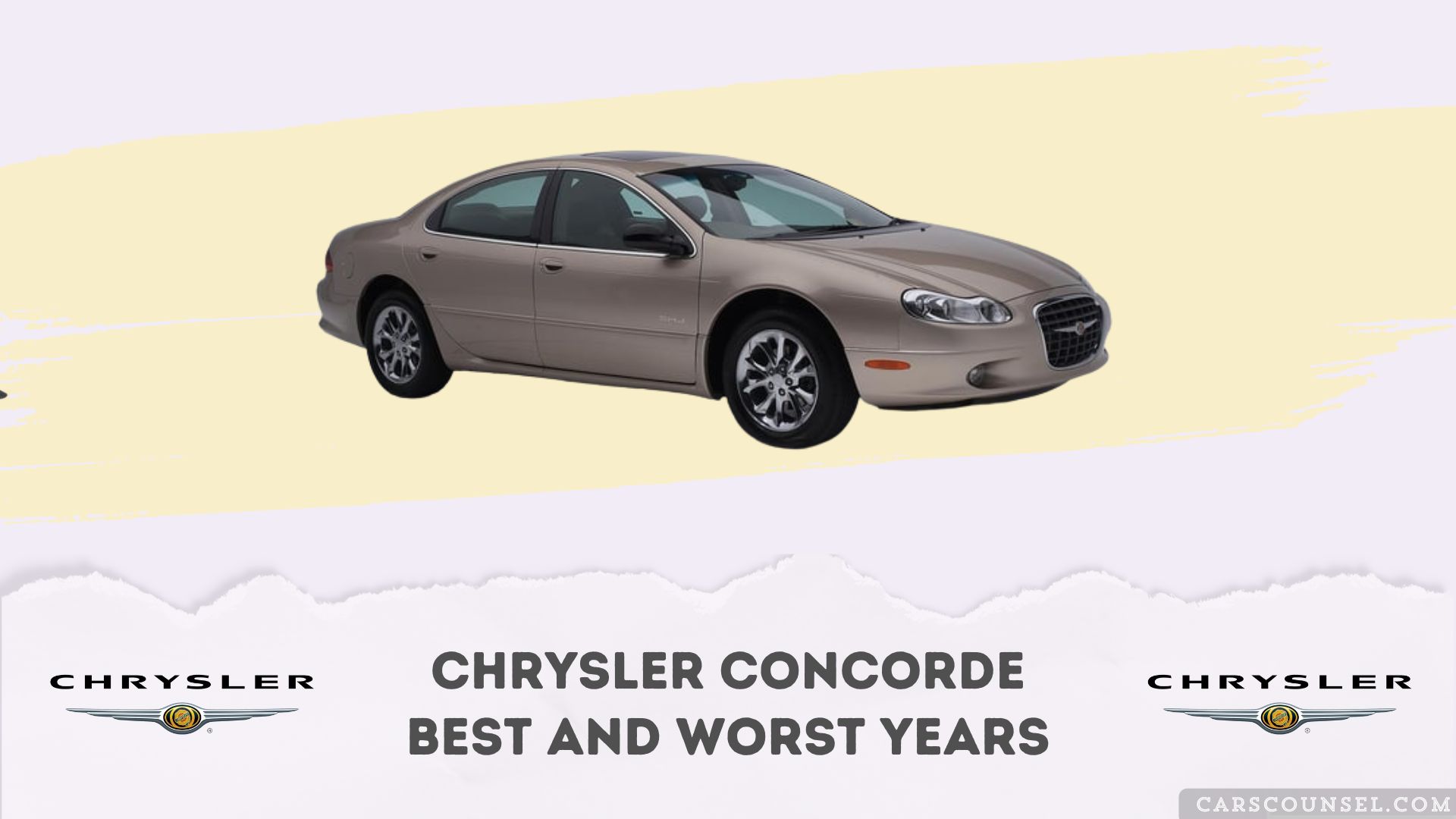As you’re considering a used Chrysler Concorde, it’s vital to know that not all model years are equal. While some offer a smooth ride and decent reliability, others are plagued by costly issues.
You’ll want to steer clear of certain years that are notorious for electrical glitches, transmission problems, and outdated interiors. But which ones? Let’s take a closer look at the best and worst years to help you make an informed decision.

Quick Navigation
Key Takeaways
- The 2002-2004 Concorde model years are considered the most reliable, offering a good balance of features and reliability with few reported issues.
- The 1993-1997 Concorde should be avoided due to electrical issues, outdated interior materials, and a PainRank of 1.6 with 143 complaints filed.
- The 1998-2001 Concorde model years are also problematic, with a PainRank of 8.51, 315 service bulletins, and 15 recall campaigns.
- Transmission issues are common in the Concorde, especially in the 1993-1997 models, and can lead to costly repairs if not addressed promptly.
- The 1993-1997 models with the 3.3L engine are particularly troublesome, with electrical gremlins and transmission issues making them the worst years to avoid.
Chrysler Concorde Model Years
The Chrysler Concorde’s production spanned over a decade, with four distinct model years that offered varying degrees of performance, comfort, and reliability.
You’ll find the first generation (1993-1997) boasted a groundbreaking cab-forward design and spacious interior, but had reported electrical issues and outdated interior materials.
The second generation (1998-2001) improved interior materials and upgraded safety features, but still had transmission issues.
The refreshed second generation (2002-2004) had minor styling tweaks and is generally considered the most reliable years of the Concorde, offering a good balance of features and reliability.
Common Problems to Watch Out For
When buying a used Chrysler Concorde, you’ll want to watch out for common issues like electrical gremlins, transmission problems, and intake manifold plenum leaks.
These problems can be costly to fix, especially if you’re dealing with a high-mileage vehicle. By being aware of these potential issues, you can make a more informed purchase decision.
Electrical Issues
As you plunge into the ownership experience of a Chrysler Concorde, electrical issues emerge as a common problem to watch out for.
These issues can range from minor glitches to significant malfunctions that affect the vehicle’s reliability.
- Faulty wipers, dim or flickering headlights, and malfunctioning interior lights and accessories were common in the first generation Concorde (1993-1997).
- Issues with the car’s computer and anti-theft system can cause problems with ignition, starting, and fuel pump, leading to costly repairs if not addressed promptly.
- Corrosion in the wiring harness and faulty electrical connections can cause electrical issues, which can be avoided with regular maintenance and inspection.
- A faulty alternator or battery can also cause electrical problems, which can be resolved by replacement or repair.
Transmission Problems
Slipping into the driver’s seat, you’ll want to be aware of transmission problems that can put a damper on your Chrysler Concorde ownership experience.
Transmission problems can manifest in various ways, including slipping or hesitation when shifting gears, unusual noises, or a sudden loss of acceleration.
If you notice any of these symptoms, it’s essential to address the issue promptly to prevent further damage.
In some cases, a software update or transmission flush may resolve the problem.
However, in more severe cases, a transmission overhaul or replacement may be necessary.
Be proactive to avoid costly repairs down the road.
Intake Leaks
You’ve got a handle on transmission problems, now it’s time to shift your focus to intake leaks, a common issue that can quietly sabotage your Chrysler Concorde’s performance.
Intake manifold plenum leaks are particularly problematic in high-mileage models.
- Leaks can cause reduced engine performance, poor fuel economy, and engine damage.
- Symptoms include decreased engine idle, misfires, and decreased fuel efficiency.
- Repairing leaks involves replacing the intake manifold gasket and resealing the plenum chamber.
- Ignoring leaks can lead to costly repairs, including replacing the engine or cylinder head.
Reliability and Maintenance Issues
In terms of maintenance issues, Chrysler Concorde owners have had their fair share of problems.
You’ll want to watch out for common problems like oil sludge in the 2.7L engine, intake manifold plenum leaks in the 3.2L and 3.5L engines, and transmission issues, especially with high mileage.
The 1993-1997 models, in particular, suffered from electrical gremlins, transmission problems, and dated interior materials.
On the other hand, the 3.5L engine is considered more reliable and has better performance.
Be prepared to address these issues to keep your Chrysler Concorde running smoothly.
Alternative Vehicle Options to Consider
Considering the reliability and maintenance issues with the Chrysler Concorde, it’s natural to investigate alternative vehicle options that can meet your needs.
If you’re looking for a similar full-size sedan, here are some options to ponder:
- Ford Crown Victoria: Known for its comfort, spacious interior, and powerful V8 engine.
- Mercury Grand Marquis: Similar features to the Crown Vic, with a more luxurious feel.
- Toyota Avalon: Offers a smooth ride, generous interior space, and strong V6 engine.
- Buick Roadmaster: Provides a comfortable ride, ample cargo space, and a powerful V8 engine.
Concorde Generations and Key Statistics
The Chrysler Concorde’s production spanned two generations, with the first running from 1993 to 1997 and the second from 1998 to 2004.
You’ll find that the first generation has a reliability rating of 9th out of 29, while the second generation ranks 17th out of 29 with 143 complaints.
The Concorde has 315 bulletins for troubleshooting common problems. Additionally, 179 owner grievances are filed to CarComplaints.com.
When considering a Concorde, you’ll want to keep these generation-specific stats in mind to make an informed decision.
Worst Years to Avoid
What makes the Chrysler Concorde’s early years so troublesome?
The first generation, spanning from 1993 to 1997, is plagued by reported electrical issues, transmission problems, and interior materials that seem outdated even for their time.
To avoid potential headaches, steer clear of the following models:
- 1993-1997 models with a PainRank of 1.6 and 143 complaints filed.
- 1998-2001 models with a PainRank of 8.51, 315 service bulletins, and 15 recall campaigns.
- 1993-1997 models featuring electrical gremlins and transmission issues, especially with the 3.3L engine.
- 1998-2001 models with oil sludge buildup, transmission problems, and intake manifold plenum leaks.
When looking at performance cars, make sure to check out our guides on models like the Chrysler Sebring, Chrysler Town & Country, Chrysler Airflow and Chrysler 200. Knowing which model years to target and which to avoid is crucial. Our expert reviews break down these models, providing insights into the years that are celebrated for their engineering excellence and driving satisfaction, as well as those that are best to avoid due to potential issues.

